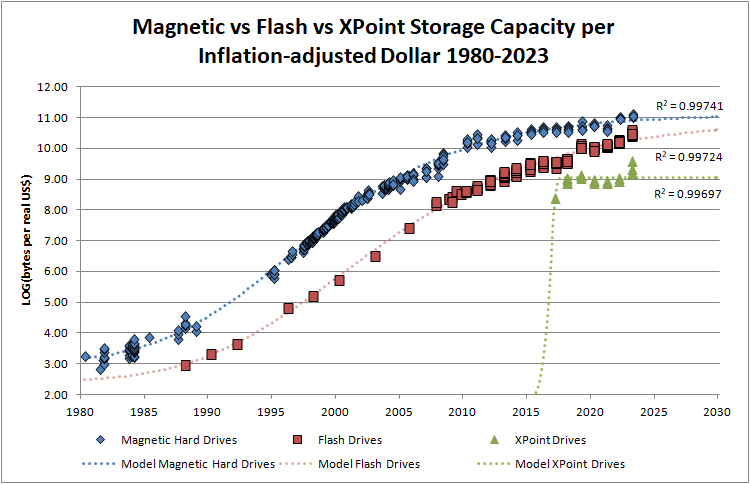Word count: 513. Estimated reading time: 3 minutes.
- Summary:
- The annual update to storage bytes per inflation-adjusted dollar is being provided for magnetic hard drives, flash SSDs, and Intel Optane XPoint devices. Raw data is being made available online, and a PDF report is being shared with the latest numbers. The study has been conducted every June since 2012, and this year’s results show significant improvements in Optane storage capacity per dollar.
Friday 2 June 2023: 11:07.
- Summary:
- The annual update to storage bytes per inflation-adjusted dollar is being provided for magnetic hard drives, flash SSDs, and Intel Optane XPoint devices. Raw data is being made available online, and a PDF report is being shared with the latest numbers. The study has been conducted every June since 2012, and this year’s results show significant improvements in Optane storage capacity per dollar.

Raw data: http://www.nedprod.com/studystuff/SSDsVsHardDrives.xlsx
This time last year I predicted:
I’m going to suggest that both hard drives and SSDs will improve again this time next year as surplus capacity fights cost of manufacture
This time last year I thought a recession would be upon us by now, as interest rates rose above inflation in order to bring it down. I still think that will happen, it just hasn’t happened yet – interest rates are indeed many times higher than last year, but inflation hasn’t really dropped by much. So either there will be recession sooner rather than later, or interest rates will have to rise some more. In any case, a recession.
I won’t predict that for this time next year, as clearly I suck at timing. Let’s look at the new numbers. Well, the big stand out thing is that Optane storage lept forwards in capacity per inflation adjusted dollar. Like so much so that it nearly entirely eliminated how much it fell behind flash storage, so now it’s nearly tracking flash storage improvements. Who knew that Intel disposing of Optane would lead to such price reductions for that technology? Here’s hoping that only improves much further still.
Flash storage saw a better than trend improvement, whilst spinning rust stayed on trend. Do you know something interesting? Flash has nearly returned to an intersection path with spinning rust for the first time since 2012! That’s kinda exciting, back in 2012 flash storage was still in its linear improvement stage, had that continued it would have overtaken and completely replaced spinning rust by 2018. Obviously the linear growth turned into exponential decrease, however with these most recent numbers the regression predicts both trends go parallel (and very close, though without crossing) from 2050 onwards.
I personally think that unlikely, you can’t eek out that amount of density from silicon, nor the cobalt based magnetic alloys of hard driver platters. So at some point well before then, I would expect both to stop improving and plateau absolutely.
The question is which will be first? My money is on silicon plateuing first. Spinning rust has been around in one form or another since the 1950s, yet improvements in data storage density have been sustained since then. Whereas silicon based storage density started much later, but saw much steeper improvements so it caught up. I still think it is a ‘flash in the pan’ compared to spinning rust, and it’ll peter out first.
Hard to predict however – much of why spinning rust can now achieve such data densities is due to sticking what was a mainframe a few decades ago onto each hard drive to crunch the maths necessary to pack data so densely. So both technologies are actually in lockstep, and if silicon stops improving, that’ll impact spinning rust as well.
| Go to previous entry | Go to next entry | Go back to the archive index | Go back to the latest entries |